It looks like you're using an Ad Blocker.
Please white-list or disable AboveTopSecret.com in your ad-blocking tool.
Thank you.
Some features of ATS will be disabled while you continue to use an ad-blocker.
12
share:
To open, I'd like to thank Skyfloating for suggesting a topic I knew nothing about, and the ATS Debate Forum for hosting, judging and following
along. Now, let's try and "crop" the weird phenomenon of Crop Circles down to size! (Har har har)
Pity the poor farmer, who upon waking one morning, walks out to his field and finds large portions of it mashed to the ground, sure signs of a destructive visitor the night before. If he's lucky, he might be able to set up a lemonade stand to sell refreshment and admission tickets to the hoard of fanatics who will further trample his field to view what is variously viewed as "art", as signs of alien activity, or as a bizarre meteorological phenomenon.
In this debate, we'll look at Crop Circles, a short history and examine their possible makers. We'll conduct a classic "Lieutenant Columbo" investigation as to the means, motive and opportunity of these agricultural vandals, and allow the reader to evaluate what the origins might be.
First off, what is a "Crop Circle"? For starters, the term isn't particularly relevant any longer, as they are not always confined to farmland:
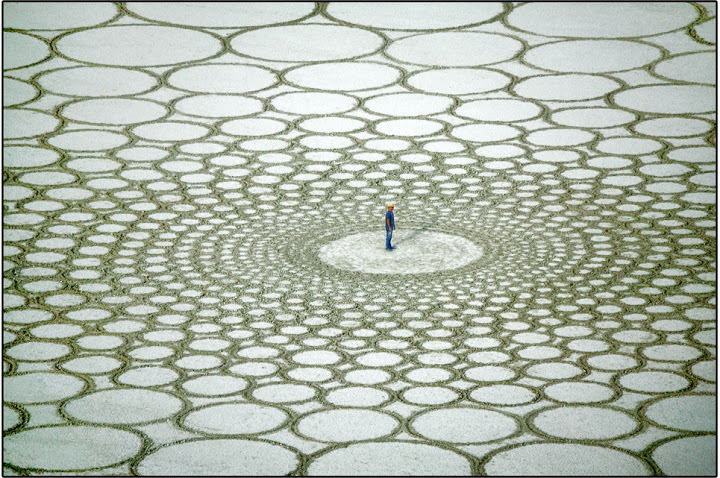
(That one is done in desert sand by the artist Jim Denevan)
Nor do they need be circles:

They can be stunningly beautiful:
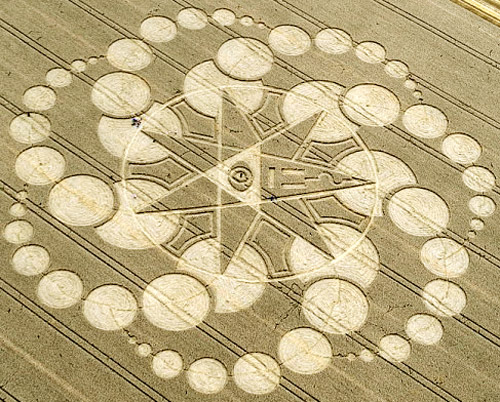
They can be idiotic:
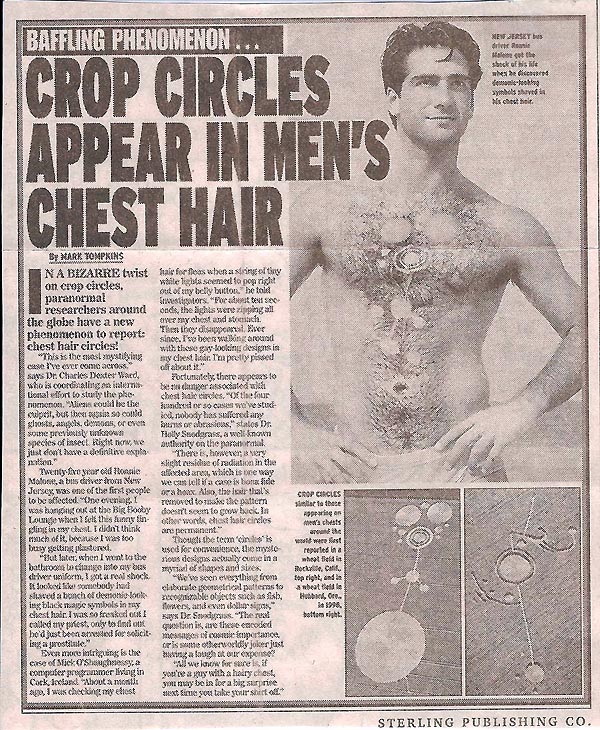
They can even be selling you something:
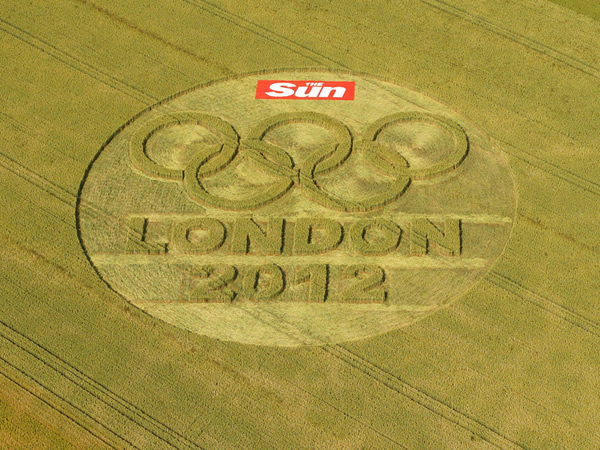
Like that one? Here's the firm that did it, and you can hire to make one for you! Curb Media
What is Curb's philosophy? From their website:
Well, fellow detectives, it appears that we've found a significant motive for human created crop circles… attention. Whether someone thinks themselves an avant grade artist, they're selling something with a method that is more notable than a sign on the side of the road, or they're just out for a good time with inebriated friends, we can see plenty of motivation.
On the "aliens did it" side? Well, the standard claim is that they're sending us messages through these pictograms, but there are two very obvious problems -- the "messages" are not notable (they never tell us anything that we didn't already know… if you want to be taken seriously, ET, give us the cure for cancer, or the secret of interstellar space flight) and this is clearly an incredibly inefficient way to send a message.
So, motive wise, we have a clear winner on the side of those phenomenon being human hoaxes. Heck, most of them these days aren't even being coached as anything but human constructs.
[atsimg]http://files.abovetopsecret.com/files/img/oa50f96536.jpg[/atsimg]
So, when did all of this craziness, which now manifests itself in hundreds of vandalism incident per year, begin?
The obvious answer, of course, is in 1947, when Kenneth Arnold made one of the first modern day UFO sightings, and who was followed by thousands of others. Clearly, the extraterrestrials had discovered the Earth after a long absence (presuming that the stories of ancient astronauts are valid) and the constant visitations resulted in loads of crop circles.
Or perhaps in 1967, when Snippy the horse was the first cited victim of the phenomenon later known as Cattle Mutilation, where isolated farms were supposedly visited by aliens, who swooped down to vivisect hapless animals and make off with various body parts.
However, though logic would say that crop circles would be tied to either of those dates, the fact of the matter is that the first known "modern" crop circle appeared in the UK in 1978, and the explosion in their creation followed media coverage in 1980. Why the disparity between these phenomenon and their supposed cause? We shall wait to hear of Skyfloating's explanation, but for the skeptic, there is a very obvious reason.
Two men by the names of Doug Bower and Dave Chorley.
We'll have a look at these two, and the "means" part of our investigation, next time. Meanwhile, over to Skyfloating for the contrarian view.
[atsimg]http://files.abovetopsecret.com/files/img/wv50f96b5b.jpg[/atsimg]
Socratic Question: It seems like one explanation for the vastly lower number of crop circles in the United States versus the United Kingdom is the increased likelihood of buckshot in the circle maker's behinds, given the prevalence of shotguns in the hands of American farmers. Would that be a factor, were these circles made by aliens with spaceships, death rays and advanced technology, or if they were a natural phenomenon?
Pity the poor farmer, who upon waking one morning, walks out to his field and finds large portions of it mashed to the ground, sure signs of a destructive visitor the night before. If he's lucky, he might be able to set up a lemonade stand to sell refreshment and admission tickets to the hoard of fanatics who will further trample his field to view what is variously viewed as "art", as signs of alien activity, or as a bizarre meteorological phenomenon.
In this debate, we'll look at Crop Circles, a short history and examine their possible makers. We'll conduct a classic "Lieutenant Columbo" investigation as to the means, motive and opportunity of these agricultural vandals, and allow the reader to evaluate what the origins might be.
First off, what is a "Crop Circle"? For starters, the term isn't particularly relevant any longer, as they are not always confined to farmland:

(That one is done in desert sand by the artist Jim Denevan)
Nor do they need be circles:

They can be stunningly beautiful:

They can be idiotic:

They can even be selling you something:

Like that one? Here's the firm that did it, and you can hire to make one for you! Curb Media
What is Curb's philosophy? From their website:
When was the last time you photographed a billboard?
In a world where consumers are bombarded with and bored by traditional linear media channels, we want to create a brand that stands for inspiring the opposite.
Well, fellow detectives, it appears that we've found a significant motive for human created crop circles… attention. Whether someone thinks themselves an avant grade artist, they're selling something with a method that is more notable than a sign on the side of the road, or they're just out for a good time with inebriated friends, we can see plenty of motivation.
On the "aliens did it" side? Well, the standard claim is that they're sending us messages through these pictograms, but there are two very obvious problems -- the "messages" are not notable (they never tell us anything that we didn't already know… if you want to be taken seriously, ET, give us the cure for cancer, or the secret of interstellar space flight) and this is clearly an incredibly inefficient way to send a message.
So, motive wise, we have a clear winner on the side of those phenomenon being human hoaxes. Heck, most of them these days aren't even being coached as anything but human constructs.
[atsimg]http://files.abovetopsecret.com/files/img/oa50f96536.jpg[/atsimg]
So, when did all of this craziness, which now manifests itself in hundreds of vandalism incident per year, begin?
The obvious answer, of course, is in 1947, when Kenneth Arnold made one of the first modern day UFO sightings, and who was followed by thousands of others. Clearly, the extraterrestrials had discovered the Earth after a long absence (presuming that the stories of ancient astronauts are valid) and the constant visitations resulted in loads of crop circles.
Or perhaps in 1967, when Snippy the horse was the first cited victim of the phenomenon later known as Cattle Mutilation, where isolated farms were supposedly visited by aliens, who swooped down to vivisect hapless animals and make off with various body parts.
However, though logic would say that crop circles would be tied to either of those dates, the fact of the matter is that the first known "modern" crop circle appeared in the UK in 1978, and the explosion in their creation followed media coverage in 1980. Why the disparity between these phenomenon and their supposed cause? We shall wait to hear of Skyfloating's explanation, but for the skeptic, there is a very obvious reason.
Two men by the names of Doug Bower and Dave Chorley.
We'll have a look at these two, and the "means" part of our investigation, next time. Meanwhile, over to Skyfloating for the contrarian view.
[atsimg]http://files.abovetopsecret.com/files/img/wv50f96b5b.jpg[/atsimg]
Socratic Question: It seems like one explanation for the vastly lower number of crop circles in the United States versus the United Kingdom is the increased likelihood of buckshot in the circle maker's behinds, given the prevalence of shotguns in the hands of American farmers. Would that be a factor, were these circles made by aliens with spaceships, death rays and advanced technology, or if they were a natural phenomenon?
The mainstream view:
My view: Most Crop Circles are not "man made hoaxes" created by pranksters who go out into a field and stomp formations into the ground. Why? Because genuine (non-hoaxed) crop circles...
* dont look as crude as hoaxed ones
* have no footprints or mud-prints leading to them or even within them
* Have the straws smoothly and evenly bent/laid-flat instead of broken
* Have the straws smoothly spiral/swirl and overlay in various patterns (imagine how long it would
take for a hoaxer/prankster to do that with each straw for up to 900 feet of crop circle)
* Often appear within minutes out of nothing (this is corroborated by numerous witnesses, including law enforcement)
* No half-finished "practice circles" have been found
* No police arrests have taken place for genuine ones
* Crops contain scientiific anomalies that cant be explained by the "prankster"-theory
Lets look at a few of the genuine ones:


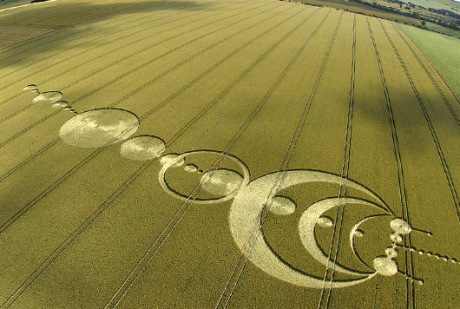
Contrast these beauties with the deliberately hoaxed ones (posted by adjensen) and you get the idea.
Debunkers have gone to absurd lengths to try and "explain" crop circles. Some "skeptics" claim that such crop formations are the result of "natural weather phenomena".
Its obvious to even the most dull reader that consciousness and intelligence are required to create such works of art. These "theories" put debunkers into a very negative light as if deliberately wanting to cover it up and make stupid people go "weather phenomena? Alright, nevermind then".
Other skeptics claim that all crop circles are man made hoaxes "because aliens dont exist". Such statements are, again, an insult to our intelligence. There could be many different explanations for genuine formations and they dont have to involve ETs, nor do most of us make such a claim. Various other possiblities are:
* From another Dimension
* Some unknown part of our own collective Consciousness
* Some unknown aspect of Earths Consciousness
* Invisible earthly Beings
* Clandestine use of human Technology
* Other unknown causes
They could be using air pressure, light, sound or means yet unknown to us. Their sudden appearance certainly suggests advanced technology.
Even the Wikipedia-Page has to admit (reluctantly, one feels):
So how has it been possible for the mainstream establishment to make the wider populace believe that crop circles are nothing but pranks? Through the laziness of the general populace to look deeper. "They said on the news that crop circles are hoaxes, so there is no point looking into it any further" they`ll say.
The good thing about crop formations however, is that the evidence is IN YOUR FACE and wont go away. With UFOs its difficult because they are vague and fleeting, here one second, gone the next. With crop circles on the other hand there have been tens of thousands across the whole world that have been photographed, measured, examined and documented. So lets enjoy a few more:
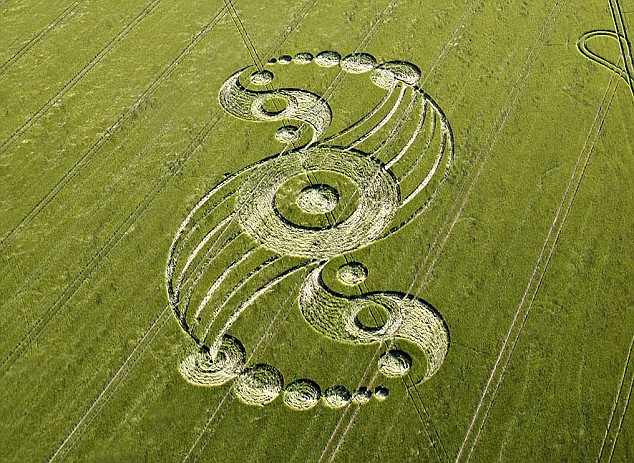

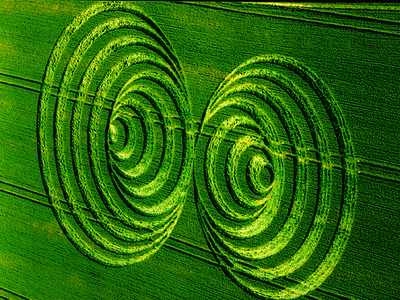
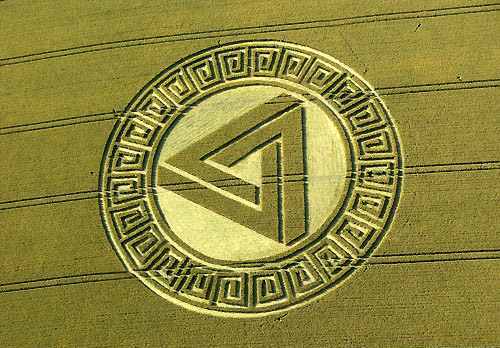
To answer my opponent: The question implies that its "either natural phenomenon or aliens with death rays". This notion I have already rejected above. That said, most crop formations appear in the county of Wiltshire, England around the areas of Avebury (which is also where Stonehenge is). Cereologists (researchers of crop circles) have proposed that there may be a connection to ancient sites.
Coming up next: Evidence that may surprise you.
*
The scientific consensus is that crop circles are predominantly man-made with perhaps some due to meteorological and other natural effects.
My view: Most Crop Circles are not "man made hoaxes" created by pranksters who go out into a field and stomp formations into the ground. Why? Because genuine (non-hoaxed) crop circles...
* dont look as crude as hoaxed ones
* have no footprints or mud-prints leading to them or even within them
* Have the straws smoothly and evenly bent/laid-flat instead of broken
* Have the straws smoothly spiral/swirl and overlay in various patterns (imagine how long it would
take for a hoaxer/prankster to do that with each straw for up to 900 feet of crop circle)
* Often appear within minutes out of nothing (this is corroborated by numerous witnesses, including law enforcement)
* No half-finished "practice circles" have been found
* No police arrests have taken place for genuine ones
* Crops contain scientiific anomalies that cant be explained by the "prankster"-theory
Lets look at a few of the genuine ones:



Contrast these beauties with the deliberately hoaxed ones (posted by adjensen) and you get the idea.
Debunkers have gone to absurd lengths to try and "explain" crop circles. Some "skeptics" claim that such crop formations are the result of "natural weather phenomena".
*
The meteorological theory became popular and it was even endorsed in 1991 by physicist Stephen Hawking who said that, "Corn circles are either hoaxes or formed by vortex movement of air"
Its obvious to even the most dull reader that consciousness and intelligence are required to create such works of art. These "theories" put debunkers into a very negative light as if deliberately wanting to cover it up and make stupid people go "weather phenomena? Alright, nevermind then".
Other skeptics claim that all crop circles are man made hoaxes "because aliens dont exist". Such statements are, again, an insult to our intelligence. There could be many different explanations for genuine formations and they dont have to involve ETs, nor do most of us make such a claim. Various other possiblities are:
* From another Dimension
* Some unknown part of our own collective Consciousness
* Some unknown aspect of Earths Consciousness
* Invisible earthly Beings
* Clandestine use of human Technology
* Other unknown causes
They could be using air pressure, light, sound or means yet unknown to us. Their sudden appearance certainly suggests advanced technology.
Even the Wikipedia-Page has to admit (reluctantly, one feels):
*
Changes to crops Scientists have found differences between the crops inside the circles and outside of them, and they are still studying them.[14][35] It has been reported that the pulvini of wheat in 95% of the crop circles investigated were elongated in a pattern falling off with distance from the centre, and that seeds from the bent-over plants grew much more slowly under controlled conditions. Furthermore, traces of crop circles patterns are sometimes found in the crop the following year, "suggesting long-term damage to the crop field consistent with Levengood’s observations of stunted seed growth." These current investigations seem to imply that at least in some crop circles, there is more at work than the effects of mechanical crushing of plants by human activity such as the use of microwaves by crop circle artists
So how has it been possible for the mainstream establishment to make the wider populace believe that crop circles are nothing but pranks? Through the laziness of the general populace to look deeper. "They said on the news that crop circles are hoaxes, so there is no point looking into it any further" they`ll say.
The good thing about crop formations however, is that the evidence is IN YOUR FACE and wont go away. With UFOs its difficult because they are vague and fleeting, here one second, gone the next. With crop circles on the other hand there have been tens of thousands across the whole world that have been photographed, measured, examined and documented. So lets enjoy a few more:




To answer my opponent: The question implies that its "either natural phenomenon or aliens with death rays". This notion I have already rejected above. That said, most crop formations appear in the county of Wiltshire, England around the areas of Avebury (which is also where Stonehenge is). Cereologists (researchers of crop circles) have proposed that there may be a connection to ancient sites.
Coming up next: Evidence that may surprise you.
Well, Skyfloating and I have certainly come to one point of agreement -- some crop circles can be pretty darn awesome.
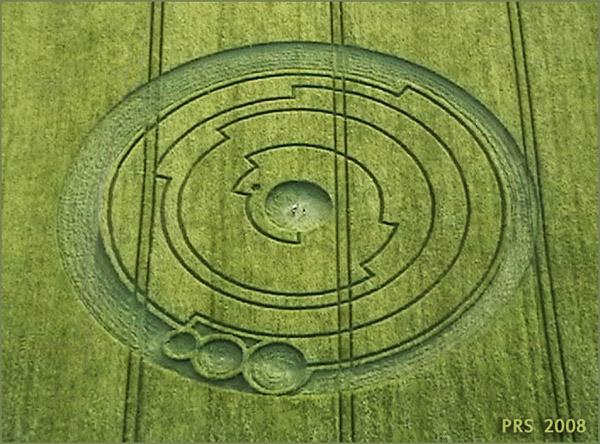
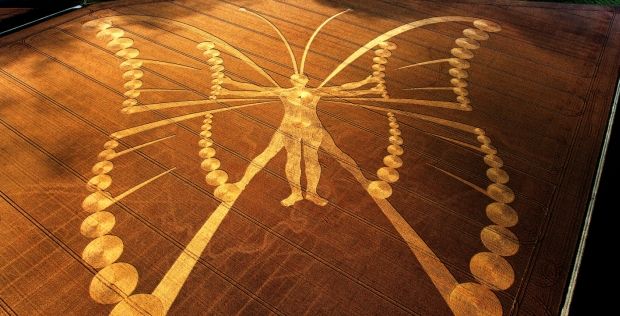
[atsimg]http://files.abovetopsecret.com/files/img/nh50f9eb3d.jpg[/atsimg]
[atsimg]http://files.abovetopsecret.com/files/img/aj50f9eb55.jpg[/atsimg]
(That last one is Quetzalcoatl's Native Headdress, no doubt foreshadowing the Mayan Apocalypse that happened last month.)
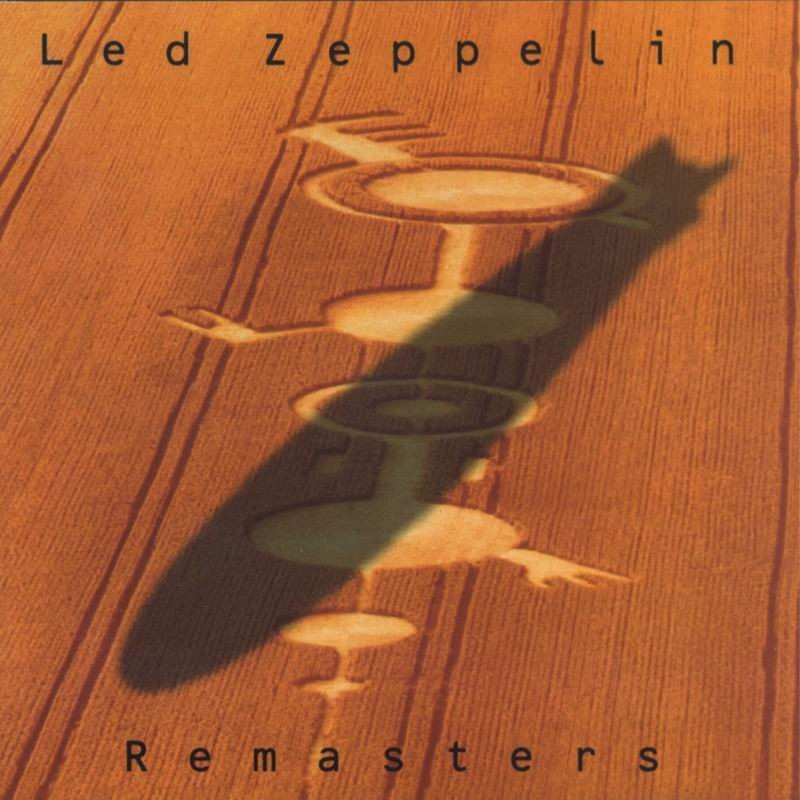
I suggest a slightly more mundane connection… if one spends a bit of time reading up on Wiltshire, one finds that the residents have a longstanding habit of grand artwork that brings people from near and far, boosting the local economy. It starts with a figure, made in 1778, the Westbury White Horse:

No aliens involved there, neither were they involved in the other twenty or so that were "cut" over the centuries, the most recent just in the past 20 years. See Wiltshire White Horses for a list.
Finally, an academic explanation of the statistical significance of crop circles near this area.
In other words, they build 'em there because they've long been building similar "landscape artistry", and there is a ready audience of people who are in the area to visit Stonehenge.
As I mentioned earlier, the history of crop circles dates, not back to 1778, but to 200 years later, when two friends took boards and ropes into a local field, carefully bent down the crop in a geometrical shape, then returned the next day to watch the reaction of the crowds. They kept it up for over a decade, with others joining in the effort, but Doug Bower and Dave Chorley confessed to the deception in 1991, in this video:
Here is a time lapse video of two people making a crop circle with similar tools to Bower and Chorley. As someone notes in the comments -- this is what two people did, what could a team of fifty do?
Need instructions? Here's a twelve step plan: How to Make a Crop Circle
I like step eleven:
Want to go high tech? Creating Crop Circles With Lasers and Microwaves (reference the use of microwaves in skyfloating's post about unusual attributes of crop circles.)
So, detectives, to our previous conclusion that human beings have the clear motivation to make crop circles, we can now add that they have the means. There are dozens, if not hundreds of in-depth articles on the creation of these artworks, and both people and companies coming forth to explain how they do it. There is no need for UFOs, mysterious vortices or other dimensions -- a couple of people, some boards, the dark of night and knowledge of geometry are about all that's required.
When solving a mystery, simple is always better than a stretch...
[atsimg]http://files.abovetopsecret.com/files/img/xj50f9f84b.jpg[/atsimg]


[atsimg]http://files.abovetopsecret.com/files/img/nh50f9eb3d.jpg[/atsimg]
[atsimg]http://files.abovetopsecret.com/files/img/aj50f9eb55.jpg[/atsimg]
(That last one is Quetzalcoatl's Native Headdress, no doubt foreshadowing the Mayan Apocalypse that happened last month.)

(oops, lol)
That said, most crop formations appear in the county of Wiltshire, England around the areas of Avebury (which is also where Stonehenge is). Cereologists (researchers of crop circles) have proposed that there may be a connection to ancient sites.
I suggest a slightly more mundane connection… if one spends a bit of time reading up on Wiltshire, one finds that the residents have a longstanding habit of grand artwork that brings people from near and far, boosting the local economy. It starts with a figure, made in 1778, the Westbury White Horse:

No aliens involved there, neither were they involved in the other twenty or so that were "cut" over the centuries, the most recent just in the past 20 years. See Wiltshire White Horses for a list.
Finally, an academic explanation of the statistical significance of crop circles near this area.
There is, then, a long history of landscape artistry in Wiltshire that preceded the crop circle phenomenon, and it is tempting to see the crop circles of Wiltshire as a continuation of this "sacred art" tradition (Fowler, 1995). It might be pointed out that Sussex, which is the location of several crop circles, also has its own local tradition of landscape artistry, featuring the Long Man of Wilmington (or the Wilmington Giant) and the white horse formation at Litlington.
The concentration of crop circles in the Avebury area, and to a lesser extent at places such as Uffington, Exeter and Sussex, would seem to relate to what Baldia (1995) found with respect to megalithic tombs in Europe - that is, that they are located along pilgrimage routes. People visit these areas for their mystical significance, and it may well be the case that crop circles are produced in sacred areas because they are made to appeal to spiritual-oriented visitors and tourists. (Spatial distribution of England's crop circles)
In other words, they build 'em there because they've long been building similar "landscape artistry", and there is a ready audience of people who are in the area to visit Stonehenge.
As I mentioned earlier, the history of crop circles dates, not back to 1778, but to 200 years later, when two friends took boards and ropes into a local field, carefully bent down the crop in a geometrical shape, then returned the next day to watch the reaction of the crowds. They kept it up for over a decade, with others joining in the effort, but Doug Bower and Dave Chorley confessed to the deception in 1991, in this video:
Here is a time lapse video of two people making a crop circle with similar tools to Bower and Chorley. As someone notes in the comments -- this is what two people did, what could a team of fifty do?
Need instructions? Here's a twelve step plan: How to Make a Crop Circle
I like step eleven:
Add "supernatural" touches to your crop circle. Add a hoax-like dimension to your work by making it appear as if aliens authored the crop circles. Here are some suggestions.
Bend some stalks around by exposing them to a blue light source for a few hours. Applying small amounts of natural gum or plaster will lock their new shape.
Want to go high tech? Creating Crop Circles With Lasers and Microwaves (reference the use of microwaves in skyfloating's post about unusual attributes of crop circles.)
So, detectives, to our previous conclusion that human beings have the clear motivation to make crop circles, we can now add that they have the means. There are dozens, if not hundreds of in-depth articles on the creation of these artworks, and both people and companies coming forth to explain how they do it. There is no need for UFOs, mysterious vortices or other dimensions -- a couple of people, some boards, the dark of night and knowledge of geometry are about all that's required.
When solving a mystery, simple is always better than a stretch...
[atsimg]http://files.abovetopsecret.com/files/img/xj50f9f84b.jpg[/atsimg]
1. Rebuttal
My opponent offers condescending snickers paired with gross falsehood. Some samples:
What? The authors of almost all crop circles remain unknown to this day!
Another one:
No. This well-known 1678 pamphlet, shows otherwise. Speaking in a context of those times it depicts crop circles as "works of the devil"
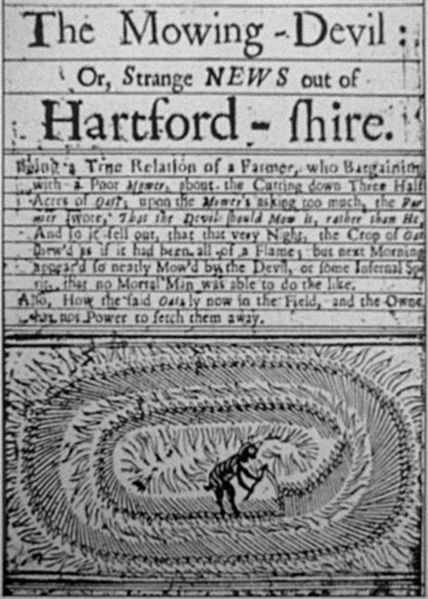
Really now? If thats true, then...
Socratic Questions
1: Where are Bower/Chorleys crop circles that come close to the magnificence of genuine ones? (And what about the thousands of CCs they did not make?)
Compare their lame "crop circles" to the out-of-this-world ones here:
Temporary Temples - Photographer Steve Alexander
Crop Circle Connector - Gallery
2: Where is the video-evidence of thousands of people out in fields night and day making these (and where are the farmer eyewitness accounts and police reports on them?)
3: How are Crop Circles made without footprints, mudprints broken straws, witnesses?
2. More Evidence
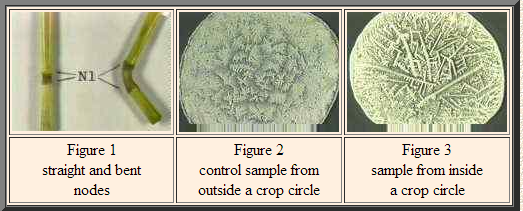
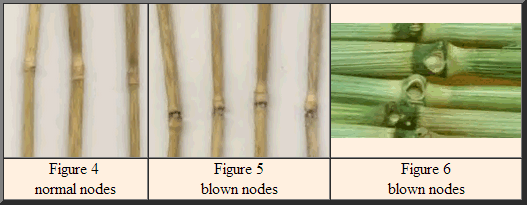
*
***
A know many of you are genuinely interested not in slapstick Detective Colombo cameos but would like to dig deeper into the fabric of reality and uncover one of the genuine mysteries of our times. And plenty of respected scientists (not mere Kooks) would agree that its worth looking into:
Loads of links to scientific research, hard evidence and papers can be found here:
Arguments against the Hoax Theory of Crop Circles
***
To provide an excellent example of a CCs appearing out of nothing in front of witnesses in broad daylight I submit the story of the 1996 "JuliaSet" as the formations are called. You can read the entire story on the page linked. In summary, a pilot (flying medical supplies) spotted the crop circle at 6:15 and confirmed it was not there at 5:30.The crop circle appearing in a very short time and without "pranksters in the field" was corroborated by several other sources. Similar stories and eyewitness accounts are repeated throughout the world.
***
Another thing adjensen seems not to be aware of is that genuine CCs are not actually stomped into the ground but rather "swirled and layered" as seen here.
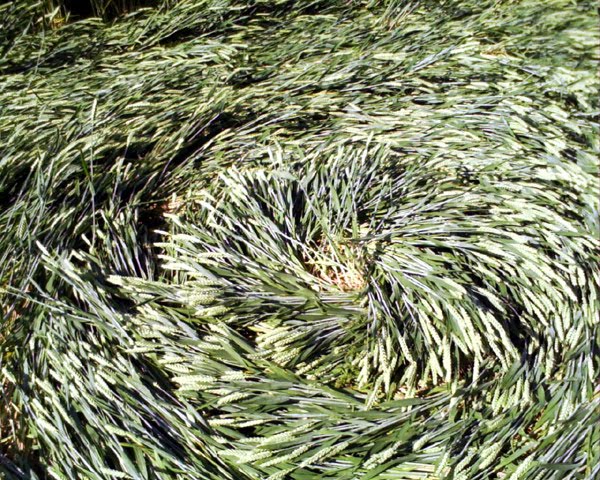
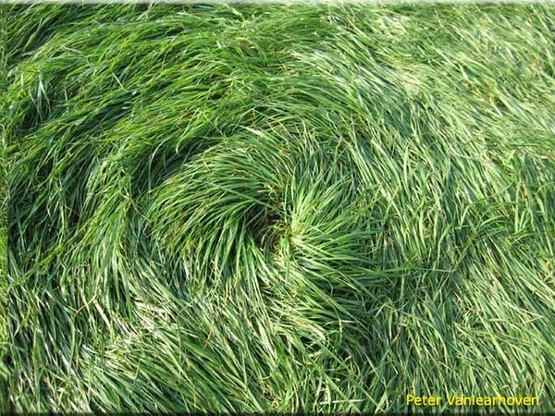
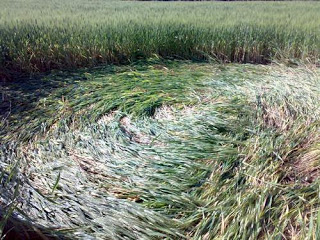
Remarkably, genuine CCs dont contain a single broken straw...quite the impossibility if we were talking about mere pranksters and hoaxers.
***
I think we quite firmly established that CCs are not mostly "hoaxes/pranks" but that something more interesting is indeed happening.
My opponent offers condescending snickers paired with gross falsehood. Some samples:
Well, fellow detectives, it appears that we've found a significant motive for human created crop circles… attention.
What? The authors of almost all crop circles remain unknown to this day!
Another one:
the history of crop circles dates, not back to 1778, but to 200 years later,
No. This well-known 1678 pamphlet, shows otherwise. Speaking in a context of those times it depicts crop circles as "works of the devil"

but Doug Bower and Dave Chorley confessed to the deception in 1991
Really now? If thats true, then...
Socratic Questions
1: Where are Bower/Chorleys crop circles that come close to the magnificence of genuine ones? (And what about the thousands of CCs they did not make?)
Compare their lame "crop circles" to the out-of-this-world ones here:
Temporary Temples - Photographer Steve Alexander
Crop Circle Connector - Gallery
2: Where is the video-evidence of thousands of people out in fields night and day making these (and where are the farmer eyewitness accounts and police reports on them?)
3: How are Crop Circles made without footprints, mudprints broken straws, witnesses?
2. More Evidence
The plants inside crop circles are changed in a way that is beyond human ability.Figure 1 is a photograph showing a normal plant stem and a stem found bent in a crop formation. The bent node of the plant from inside a crop formation is elongated yet undamaged. Plant stems bent by people via mechanical means appear damaged and do not have the elongated nodes.Figures 2 and 3 are photographs demonstrating the microscopic changes in a plant inside a crop circle compared to a control sample taken from the same field.

Plants inside crop formations often have "blown nodes." Figure 4 is a photograph of the normal nodes of plants taken from outside of a crop formation. Figure 5 above is a photograph of the blown nodes of plants found inside the crop formation. Figure 6 is another example of the blown nodes of plants taken from inside a crop formation. Other changes to the plants have been reported by Dr. W.C. Levengood and his BLT team, including stunted seed-heads, cell-wall pit enlargement, and expulsion cavities.

*
***
A know many of you are genuinely interested not in slapstick Detective Colombo cameos but would like to dig deeper into the fabric of reality and uncover one of the genuine mysteries of our times. And plenty of respected scientists (not mere Kooks) would agree that its worth looking into:
Crop circles are usually explained as the handiwork of creative pranksters. `Not true,' says Dr. Eltjo H. Haselhoff, Ph.D., former employee of Los Alamos National Laboratories. `The complexity of the crop circle phenomenon is tremendously underestimated, because its true nature is unknown to the general public.' `Obviously, there are people trying to imitate the real thing, but the suggestion that all of these crop formations are made by men with simple flattening tools is by far insufficient to explain the well-documented observations, like unambiguous and consistent biophysical anomalies in the flattened plants, inside the circles, all of which have been published in peer-reviewed scientific literature,' according to Dr. Haselhoff.
Loads of links to scientific research, hard evidence and papers can be found here:
Arguments against the Hoax Theory of Crop Circles
***
To provide an excellent example of a CCs appearing out of nothing in front of witnesses in broad daylight I submit the story of the 1996 "JuliaSet" as the formations are called. You can read the entire story on the page linked. In summary, a pilot (flying medical supplies) spotted the crop circle at 6:15 and confirmed it was not there at 5:30.The crop circle appearing in a very short time and without "pranksters in the field" was corroborated by several other sources. Similar stories and eyewitness accounts are repeated throughout the world.
***
Another thing adjensen seems not to be aware of is that genuine CCs are not actually stomped into the ground but rather "swirled and layered" as seen here.



Remarkably, genuine CCs dont contain a single broken straw...quite the impossibility if we were talking about mere pranksters and hoaxers.
***
I think we quite firmly established that CCs are not mostly "hoaxes/pranks" but that something more interesting is indeed happening.
In any investigation of a crime, incident or phenomenon, as we all know, the solution is found by carefully collecting the facts, eliminating
suspects, and finally coming to a reasonable conclusion. We are not likely to come to a correct conclusion if we discard evidence for no reason, pose
implausible solutions or decide that the most unlikely of solutions is actually correct.
We have seen that crop circles are a relatively new phenomenon -- the 1678 case cited by skyfloating seems similar, but is a folktale with only a single thing in common - a circle in the grass. However, it was mowed, not flattened, and by the devil, not by a UFO. In other words, not the same thing.
We have also seen that there is a confession to the act on record, which coincides with the modern era of crop circles, beginning in 1978 -- that of Bower and Chorley. No, the two are obviously not responsible for every crop circle (Socratic Question 1,) Dave being dead and Doug being in his eighties, but they admit to coming up with the idea, and demonstrated on film how it is done. Contrary to my opponent's claims, "swirling" laying down of crops is exactly what their "boards and rope" method would result in -- in your mind, set the board flat, stand on one end, lift the other, move it over, set it down, repeat… makes a swirl, doesn't it?
Question #2 -- you want a video?
As you can see, that's a complicated design, it was done in one night, and needed but a handful of people to create.
Question #3 -- from the "12 steps" article I posted before:
It is obvious that most hoaxers do such anonymously (though still enjoying the fruits of their labour, among their community, much as the anonymous members of ATS enjoy the appreciation of the ATS community,) because of legalities, but there are some that operate in the open, beyond the advertising firms that make circles for pay. Here is one: Circlemakers which has an extensive site, full of resources, including computer software that aids in circle design.
Though we have seen ironclad, irrefutable evidence that humans are responsible for crop circles, and absolutely no evidence that aliens are behind any of them, much less all of them, the "I want to believe" crowd tries to hang onto their claim by any contrived means possible.
So, detectives, let's take another look at the facts of this case. We have a confession on record, we have solid examples of people making all sorts of crop circles, we have computer software, user groups, advertising firms and fan clubs based on crop circles. We've seen pictures, videos and interviews that conclusively prove that humans are making these pieces of art. We have seen means, motive and opportunity for humans being behind crop circles. My opponent, on the other hand, has presented dodgy testimony and pseudoscience to buttress his opinion that crop circles are not a man made hoax.
The facts in this case clearly indicate that he is wrong.
Detectives… case closed.

But before we leave, sir, I wonder if you'd look at this brief pictorial history of crop circles…
1980:

1990:
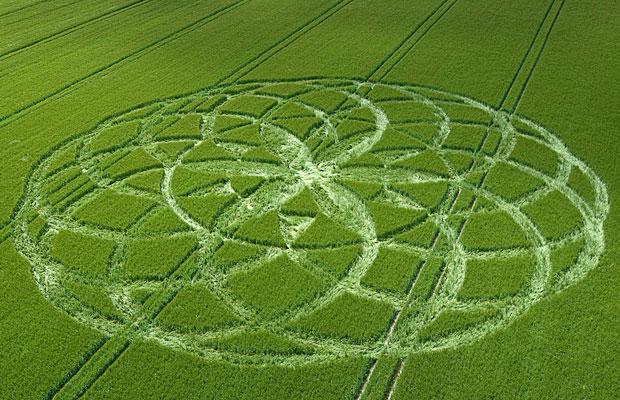
2000:

2012:
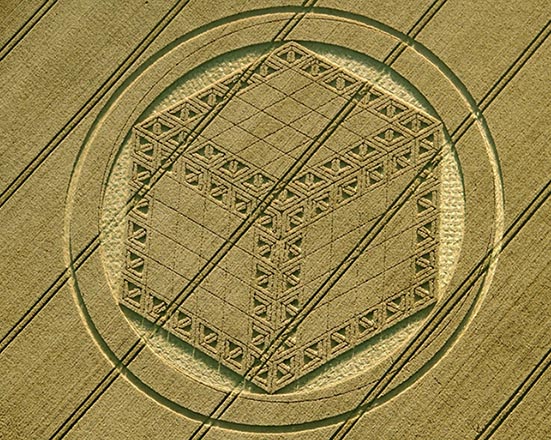
We've seen that, from 1978 to 2012, humans have gone from two guys with boards and ropes to computer software, GPS aided design and organized teams, which certainly accounts for this natural progression of complexity from crude to complex.
But aliens? Are we to believe that aliens who can travel across the galaxy to carve pointless "geotags" into farmland had a similar learning curve?
We have seen that crop circles are a relatively new phenomenon -- the 1678 case cited by skyfloating seems similar, but is a folktale with only a single thing in common - a circle in the grass. However, it was mowed, not flattened, and by the devil, not by a UFO. In other words, not the same thing.
We have also seen that there is a confession to the act on record, which coincides with the modern era of crop circles, beginning in 1978 -- that of Bower and Chorley. No, the two are obviously not responsible for every crop circle (Socratic Question 1,) Dave being dead and Doug being in his eighties, but they admit to coming up with the idea, and demonstrated on film how it is done. Contrary to my opponent's claims, "swirling" laying down of crops is exactly what their "boards and rope" method would result in -- in your mind, set the board flat, stand on one end, lift the other, move it over, set it down, repeat… makes a swirl, doesn't it?
Question #2 -- you want a video?
As you can see, that's a complicated design, it was done in one night, and needed but a handful of people to create.
Question #3 -- from the "12 steps" article I posted before:
Enter the field on the tramline. If the field is active, there will be deep tram, or tractor, tracks crossing it at several points. Walk inside these tracks so as not to make footprints. When you've reached the location of your planned circle, walk off the tracks such that your crop circle will cover your footprints. Leave the same way.
It is obvious that most hoaxers do such anonymously (though still enjoying the fruits of their labour, among their community, much as the anonymous members of ATS enjoy the appreciation of the ATS community,) because of legalities, but there are some that operate in the open, beyond the advertising firms that make circles for pay. Here is one: Circlemakers which has an extensive site, full of resources, including computer software that aids in circle design.
Though we have seen ironclad, irrefutable evidence that humans are responsible for crop circles, and absolutely no evidence that aliens are behind any of them, much less all of them, the "I want to believe" crowd tries to hang onto their claim by any contrived means possible.
- Plant abnormalities? From your own source:
An important final note regarding these changes to crop circle plants is the fact that non-geometrically-downed crop -- usually called "lodging" by farmers and attributed to over-fertilization of the field and/or subsequent weather damage -- has sometimes been found to show these same changes. This more randomly-downed, or chaotically-downed crop is often observed in the same fields in which "geometric" crop circles occur, but is also found in fields where no geometric crop circle exists.
In other words, these changes are also found in plants NOT in crop circles, so they are not necessarily related.
- Dr. Eltjo H. Haselhoff? Debunked as invalid science
- "Julia Set" event? Ask the Circlemakers
So, detectives, let's take another look at the facts of this case. We have a confession on record, we have solid examples of people making all sorts of crop circles, we have computer software, user groups, advertising firms and fan clubs based on crop circles. We've seen pictures, videos and interviews that conclusively prove that humans are making these pieces of art. We have seen means, motive and opportunity for humans being behind crop circles. My opponent, on the other hand, has presented dodgy testimony and pseudoscience to buttress his opinion that crop circles are not a man made hoax.
The facts in this case clearly indicate that he is wrong.
Detectives… case closed.

But before we leave, sir, I wonder if you'd look at this brief pictorial history of crop circles…
1980:

1990:

2000:

2012:

We've seen that, from 1978 to 2012, humans have gone from two guys with boards and ropes to computer software, GPS aided design and organized teams, which certainly accounts for this natural progression of complexity from crude to complex.
But aliens? Are we to believe that aliens who can travel across the galaxy to carve pointless "geotags" into farmland had a similar learning curve?
Grand Rebuttal
You keep referencing UFOs/Aliens, although I have provided a whole list of possible explanations. The "its not aliens" argument is a straw man deflection used by debunkers to ridicule. You resort to ad hominem attacks because you have nothing to counter the evidence with. Its likely neither "the devil" nor "UFOs" but something we do not fully understand yet. Farmers, who have been observing the phenomena for decades have witnessed neither UFOs, nor pranksters in their fields. If it were one of those they'd have seen plenty of them.
Just because someone takes credit does not mean its true. I could take credit for creating ATS, but havent. They'd have to demonstrate HOW they achieve the level of out-of-this-world artistry the normal crop circles have...but they havent. In fact, after 1991, when Bower and Chorley came out saying "it was us" coincided with the time crop circles suddenly became much more sophisticated as if to say "nope, not made by hoaxers".
A board would not result in swirled layers and it would their stomping around would most certainly result in crushed and broken straws!!!!!
The "circlemakers" came in long after the fact and with the permission of farmers and law enforcement.
I was asking for videos showing what must have been thousands of people trampling across fields. Apart from these hoaxed imitations you cannot provide any evidence whatsoever of hoards of people making genuine CCs. After many decades of CCs farmers would have had to have plenty of footage and police would have had to make numerous arrests. Farmers losses due to these disruptions are substantial.
So we are expected to believe that 600 to 20 000 foot formations appearing all over the place without witnesses, without crushed straws, without footprints are because they walked "inside these tracks?"- If they stepped on straws they would have broken them. If there were no straws there would have been footprints. However, after 25 years of intense examination, such tracks are not found with genuine CCs.
You drop youtube vidos because you cant explain in your own words how they do it. Designing stuff on a computer is a little different than going out into a field at night. The way you propose it it would quickly be seen by farmers, pedestrians and law enforcement. While I am willing to entertain the idea that hoaxers are responsible, we would need to see something a little more compelling than CircleMakers which, by the way, show all the signs of human activity: Footprints, crushed straws, lots of light and action in the field, etc.
We have seen evidence that humans are behind mediocre looking imitations that dont even come close to the originals. The reason you posted so many genuine circles is in the hopes of deceiving readers into thinking they are made by pranksters. What you did not post was what these crude hoaxes actually look like. Here you go:
Hoax:
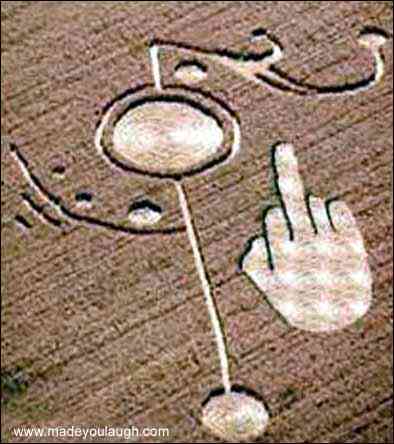
*
The crop inside the circle is not chaotically-downed, except for outside the circle. Of course such crop would also exist in fields without a circle. Is this what passes for "debunking" these days?
Again you just lazily drop a link without explaining, in your own words WHY a particular source "debunks" a source that I used. That indicates that you dont know how to debunk the points raised.
Wrong. We have seen that hoaxers CCs are crude and genuine CCs are sublime.
I trust that I have clearly demonstrated that human hoaxsters are NOT behind the genuine crop circles but that the mystery is yet UNEXPLAINED. Dear Reader, I thank you for your attention.
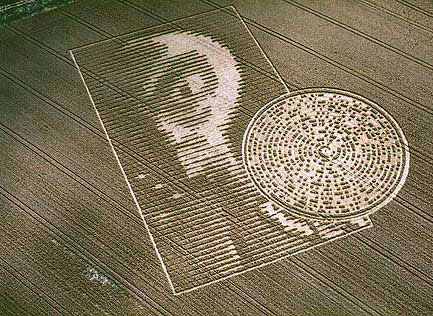
and by the devil, not by a UFO. In other words, not the same thing.
You keep referencing UFOs/Aliens, although I have provided a whole list of possible explanations. The "its not aliens" argument is a straw man deflection used by debunkers to ridicule. You resort to ad hominem attacks because you have nothing to counter the evidence with. Its likely neither "the devil" nor "UFOs" but something we do not fully understand yet. Farmers, who have been observing the phenomena for decades have witnessed neither UFOs, nor pranksters in their fields. If it were one of those they'd have seen plenty of them.
but they admit to coming up with the idea, and demonstrated on film how it is done.
Just because someone takes credit does not mean its true. I could take credit for creating ATS, but havent. They'd have to demonstrate HOW they achieve the level of out-of-this-world artistry the normal crop circles have...but they havent. In fact, after 1991, when Bower and Chorley came out saying "it was us" coincided with the time crop circles suddenly became much more sophisticated as if to say "nope, not made by hoaxers".
"swirling" laying down of crops is exactly what their "boards and rope" method would result in -
A board would not result in swirled layers and it would their stomping around would most certainly result in crushed and broken straws!!!!!
you want a video?
The "circlemakers" came in long after the fact and with the permission of farmers and law enforcement.
I was asking for videos showing what must have been thousands of people trampling across fields. Apart from these hoaxed imitations you cannot provide any evidence whatsoever of hoards of people making genuine CCs. After many decades of CCs farmers would have had to have plenty of footage and police would have had to make numerous arrests. Farmers losses due to these disruptions are substantial.
Walk inside these tracks so as not to make footprints.
So we are expected to believe that 600 to 20 000 foot formations appearing all over the place without witnesses, without crushed straws, without footprints are because they walked "inside these tracks?"- If they stepped on straws they would have broken them. If there were no straws there would have been footprints. However, after 25 years of intense examination, such tracks are not found with genuine CCs.
including computer software that aids in circle design.
You drop youtube vidos because you cant explain in your own words how they do it. Designing stuff on a computer is a little different than going out into a field at night. The way you propose it it would quickly be seen by farmers, pedestrians and law enforcement. While I am willing to entertain the idea that hoaxers are responsible, we would need to see something a little more compelling than CircleMakers which, by the way, show all the signs of human activity: Footprints, crushed straws, lots of light and action in the field, etc.
Though we have seen ironclad, irrefutable evidence that humans are responsible for crop circles, and absolutely no evidence that aliens are behind
We have seen evidence that humans are behind mediocre looking imitations that dont even come close to the originals. The reason you posted so many genuine circles is in the hopes of deceiving readers into thinking they are made by pranksters. What you did not post was what these crude hoaxes actually look like. Here you go:
Hoax:

*
This more randomly-downed, or chaotically-downed crop is often observed in the same fields in which "geometric" crop circles occur, but is also found in fields where no geometric crop circle exists.
The crop inside the circle is not chaotically-downed, except for outside the circle. Of course such crop would also exist in fields without a circle. Is this what passes for "debunking" these days?
Dr. Eltjo H. Haselhoff? Debunked as invalid science
Again you just lazily drop a link without explaining, in your own words WHY a particular source "debunks" a source that I used. That indicates that you dont know how to debunk the points raised.
We've seen that, from 1978 to 2012, humans have gone from two guys with boards and ropes to computer software, GPS aided design and organized teams, which certainly accounts for this natural progression of complexity from crude to complex.
Wrong. We have seen that hoaxers CCs are crude and genuine CCs are sublime.
I trust that I have clearly demonstrated that human hoaxsters are NOT behind the genuine crop circles but that the mystery is yet UNEXPLAINED. Dear Reader, I thank you for your attention.

And the decision is:
The winner is Skyfloating.
In college, some friends and I almost did a crop circle. We were skeptical of alien influence and wanted to cause trouble.
So I started this debate in full support of adjensen and perhaps a little biased in the topic. I thought adjensen did a fine job of laying out the evidence and supported his side admirably.
But then I read skyfloating's posts She also did a great job of supporting the idea that the crop circles were not man-made.
In the end though, it has to go to skyfloating because I now believe that intervention by other than pranksters is "plausible".
Great job to both!
Oh boy, this was an entertaining debate to read, but it came down in the end to who made the better argument for the unexplained nature of some crop circles, and while there was no debating that some were in fact man made hoaxes, (as there is with much in the world) Skyfloating had the edge with clear, well thought out logic and proof to back up her claims. Adjensen never quite got over the 1700's crop circle that to this day remains unexplained.
The winner by an overwhelming margin would be Skyfloating.
The winner is Skyfloating.
new topics
-
Breakthrough treatment flips cancer cells back into normal cells
General Chit Chat: 9 minutes ago -
New World Order Coming?
New World Order: 46 minutes ago -
Short vs. Long?
General Chit Chat: 9 hours ago
top topics
-
Outgoing Lame Duck BIDEN Officials and Democrats Voice Their Regrets.
2024 Elections: 13 hours ago, 9 flags -
Reflections of Elections past
US Political Madness: 15 hours ago, 5 flags -
Short vs. Long?
General Chit Chat: 9 hours ago, 4 flags -
New World Order Coming?
New World Order: 46 minutes ago, 1 flags -
Breakthrough treatment flips cancer cells back into normal cells
General Chit Chat: 9 minutes ago, 0 flags
active topics
-
Trump's idea to make Canada the 51st US state: 'Potential is massive'
Mainstream News • 131 • : lilzazz -
Outgoing Lame Duck BIDEN Officials and Democrats Voice Their Regrets.
2024 Elections • 15 • : Xtrozero -
New World Order Coming?
New World Order • 6 • : charlest2 -
Breakthrough treatment flips cancer cells back into normal cells
General Chit Chat • 0 • : alwaysbeenhere2 -
President Carter has passed
Mainstream News • 19 • : BernnieJGato -
Short vs. Long?
General Chit Chat • 11 • : Athetos -
Mood Music Part VI
Music • 3770 • : underpass61 -
Post A Funny (T&C Friendly) Pic Part IV: The LOL awakens!
General Chit Chat • 7968 • : PinkFreud -
Plane Crash in South Korea
Mainstream News • 18 • : Shoshanna -
Why Such An Uproar Over Non-US Citizens With H1-B Work Visas.
Social Issues and Civil Unrest • 86 • : Xtrozero
12
